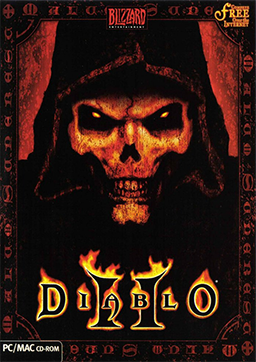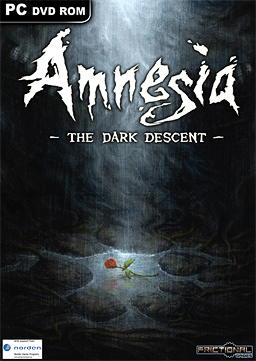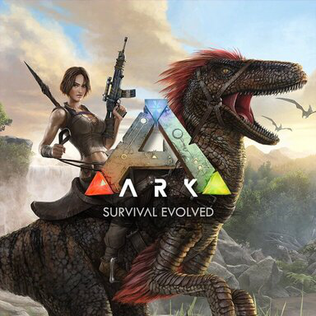
Capcom Co., Ltd. is a Japanese video game company. It has created a number of multi-million-selling game franchises, with its most commercially successful being Resident Evil, Monster Hunter, Street Fighter, Mega Man, Devil May Cry, Dead Rising, Ace Attorney, and Marvel vs. Capcom. Established in 1979, it has become an international enterprise with subsidiaries in East Asia, Europe, and North America.

Diablo II is an action role-playing hack-and-slash video game developed by Blizzard North and published by Blizzard Entertainment in 2000 for Microsoft Windows, Classic Mac OS, and macOS. The game, with its dark fantasy and horror themes, was conceptualized and designed by David Brevik and Erich Schaefer, who, with Max Schaefer, acted as project leads on the game. The producers were Matthew Householder and Bill Roper. The game was developed over a three-year period, with a crunch time of a year and a half.
Survival horror is a subgenre of horror games. Although combat can be part of the gameplay, the player is made to feel less in control than in typical action games through limited ammunition or weapons, health, speed, and vision, or through various obstructions of the player's interaction with the game mechanics. The player is also challenged to find items that unlock the path to new areas and solve puzzles to proceed in the game. Games make use of strong horror themes, such as dark mazelike environments and unexpected attacks from enemies.

Castlevania, known in Japan as Akumajō Dracula, is a gothic horror action-adventure video game series and media franchise about Dracula, created and developed by Konami. It has been released on various platforms, from early systems to modern consoles, as well as handheld devices such as mobile phones. The franchise has expanded into several spin-off video games and other media, including comic books and an animated television series.

Ys VI: The Ark of Napishtim is a 2003 action role-playing game developed by Nihon Falcom. It was first released for Windows before being ported by Konami to the PlayStation 2 in 2005 and the PlayStation Portable in 2006. It was the first English release of the series since Ys III: Wanderers from Ys, and the first to make it to Europe since the Master System version of Ys I: Ancient Ys Vanished, the European version also being the first game in the series to be localized to western languages other than English. An English localization of the Windows version was released by Xseed Games in 2015. Ys VI was used as a base for Ys VI Mobile, a free-to-play MMORPG released in Japan in 2021 and worldwide in 2022.

Mystery House is an adventure game released by On-Line Systems in 1980. It was designed, written and illustrated by Roberta Williams, and programmed by Ken Williams for the Apple II. Mystery House is the first graphical adventure game and the first game produced by On-Line Systems, the company which would evolve into Sierra On-Line. It is one of the earliest horror video games.

Simon the Sorcerer II: The Lion, the Wizard and the Wardrobe is an adventure game created by Adventure Soft, and released in 1995 for the MS-DOS. It is the second installment in the Simon the Sorcerer series of games, and the sequel to 1993's Simon the Sorcerer. The game's story focuses on a young teen named Simon, who is transported into a parallel universe of magic and monsters that he visited before, via a magical wardrobe created by an evil sorcerer he defeated in the last game. Players engage in a quest to help him find more fuel for the wardrobe by searching a vast world, consisting of parodies on popular fantasy novels and fairy tales.

Alone in the Dark is a 1992 survival horror video game designed by Frédérick Raynal. Developed and published by Infogrames in 1992 for MS-DOS, the game was eventually ported to MacOS, the PC-98, the FM Towns, the 3DO, the Acorn Archimedes, and iOS. Alone in the Dark is set in 1920s Louisiana and challenges the player to escape a haunted mansion. To advance, the player must solve puzzles while banishing, slaying, or eluding various ghosts and monsters. The player can collect and use weapons, manage a weight-based inventory system, and explore a partially nonlinear map.

Penumbra: Overture is the first in a series of episodic survival horror games developed by Frictional Games. The game follows a physicist named Philip who travels to Greenland after his mother's death and is forced to explore an abandoned mine. Penumbra: Overture received average reception from critics.

Frictional Games AB is a Swedish independent video game developer based in Malmö, founded in January 2007 by Thomas Grip and Jens Nilsson. The company specialises in the development of survival horror games with very little or no combat gameplay mechanics. It is best known for its games Amnesia: The Dark Descent and Soma.

Resident Evil 6 is a 2012 third-person shooter video game developed and published by Capcom. A major installment in the Resident Evil series, Resident Evil 6 was released for the PlayStation 3 and Xbox 360 in October 2012, and for Windows in March 2013. It was re-released with all downloadable content for the PlayStation 4 and Xbox One in March 2016, and for the Nintendo Switch in October 2019. Players control Leon S. Kennedy, Chris Redfield, Jake Muller and Ada Wong as they confront the force behind a worldwide bio-terrorist attack. The story is centred around their four interwoven campaigns, and every campaign features a unique style in both tone and gameplay.

Amnesia: The Dark Descent is a 2010 survival horror adventure game developed and published by Frictional Games. It was released in 2010 for Microsoft Windows, Mac OS X and Linux operating systems, in 2016 for the PlayStation 4 platform and in 2018 for the Xbox One. The game features a protagonist named Daniel exploring a dark and foreboding castle called Brennenburg, while trying to maintain his sanity by avoiding monsters and unsettling events. The game was critically well-received, earning two awards from the Independent Games Festival and numerous positive reviews.

Amnesia: A Machine for Pigs is a 2013 survival horror game developed by The Chinese Room and published by Frictional Games. Originally meant to be a mod, the game is an indirect sequel to Amnesia: The Dark Descent (2010), which was both developed and published by Frictional Games. While set in the same universe as the previous game, it features a new cast of characters and time setting.

Ark: Survival Evolved is a 2015 action-adventure survival video game developed by Studio Wildcard. In the game, players must survive being stranded on one of several maps filled with roaming dinosaurs, fictional fantasy monsters, and other prehistoric animals, natural hazards, and potentially hostile human players.
Undertale is a 2015 2D role-playing video game created by American indie developer Toby Fox. The player controls a child named Frisk who has fallen into the Underground: a large, secluded region under the surface of the Earth, separated by a magical barrier. The player meets various monsters during the journey back to the surface, although some monsters might engage the player in a fight. The combat system involves the player navigating through mini-bullet hell attacks by the opponent. They can opt to pacify or subdue monsters in order to spare them instead of killing them. These choices affect the game, with the dialogue, characters, and story changing based on outcomes.
A horror game is a video game genre centered on horror fiction and typically designed to scare the player. The term may also be used to describe tabletop games with horror fiction elements.

Amnesia: Rebirth is a 2020 survival horror video game developed and published by Frictional Games. It was released for Windows, Linux, and PlayStation 4 on 20 October 2020, for Amazon Luna on 22 October 2021, and for Xbox One and Xbox Series X/S on 20 October 2022. It is the third installment in the franchise and serves as a sequel to Amnesia: The Dark Descent (2010). The game received generally favorable reviews.

Alone in the Dark is a 2024 survival horror video game developed by Pieces Interactive and published by THQ Nordic. The game is a reimagining of the original 1992 Alone in the Dark and is the seventh installment in the Alone in the Dark video game series. The game features a single-player narrative set in the 1930s, where players can choose to play as Edward Carnby or Emily Hartwood, as they make their way through Derceto Mansion to uncover the mysteries within. It was released for PlayStation 5, Windows, and Xbox Series X/S on 20 March 2024. Upon release, it received mixed reviews from critics.
















